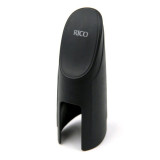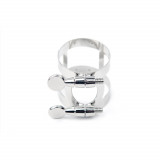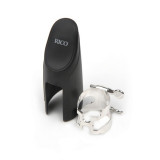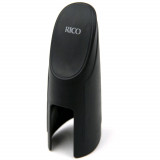 Everyone knows Rico reeds, and everyone knows that virtually every clarinetist or saxophonist has, at one time or another, played with a Rico reed. But what do we know about the origins of today's largest reed manufacturer and distributor? It all started in France with Joseph Rico in 1928. Born in Italy, Joseph Rico (1876-1957) went to seminary school near Naples, where he showed special talent for music. As a teenager, he and his brother, Libereto, ran away from seminary school one night, embarked on a ship, and fled to America where they heard there was a world of opportunity for eager minds. Joseph was a harpist, pianist, and guitarist, and his brother was a mandolinist and violinist. As a result of their hard work, both musicians became quite well known in Chicago and New York. Joseph Rico started composing and conducting, and went on to Paris where he became a sought-after composer. His Valses lentes are still played today.
Everyone knows Rico reeds, and everyone knows that virtually every clarinetist or saxophonist has, at one time or another, played with a Rico reed. But what do we know about the origins of today's largest reed manufacturer and distributor? It all started in France with Joseph Rico in 1928. Born in Italy, Joseph Rico (1876-1957) went to seminary school near Naples, where he showed special talent for music. As a teenager, he and his brother, Libereto, ran away from seminary school one night, embarked on a ship, and fled to America where they heard there was a world of opportunity for eager minds. Joseph was a harpist, pianist, and guitarist, and his brother was a mandolinist and violinist. As a result of their hard work, both musicians became quite well known in Chicago and New York. Joseph Rico started composing and conducting, and went on to Paris where he became a sought-after composer. His Valses lentes are still played today.
 In 1926, Joseph's nephew, Frank De Michele, a clarinetist with Walt Disney studios, wrote to him complaining about how hard it was to find good reeds in Los Angeles. He wrote: "Uncle Joe, you are so well established in the musical scene in Paris, I'm sure you could find all kinds of good reeds for me." Joseph easily found reeds to send him, but three weeks later, Frank wrote again: "My friends liked the reeds you sent so much, I have none left for myself. Could you please send me more?" After a series of similar letters, Joseph's reed supplier bowed out, explaining that he could no longer provide reeds because of a shortage of cane. His nephew asked Joseph if he could at least send some cane so that he could try making his own reeds. Joseph had a vacation cottage in the Var region of southern France where he found excellent reed cane. In 1928, Joseph Rico sent the first shipment of 350 kilos of reed cane to America. To honor his uncle, Frank asked if he could use his uncle's name to launch his first reed line. Soon thereafter, Frank De Michele found partners, including musician and engineer Roy J. Maier to create a reed factory in the U.S. And thus the company name: Rico. The story behind Roy J. Maier's design and development of the world's most popular reed is an interesting one. It reveals a corollary interest in engineering, music, and reed research starting in the 1920s with his first appearance as a sax and clarinet player. Soon, Maier had worked his way up in America's premier bands, appearing as a member of Paul Whiteman's band, the star-studded ensemble of the '20s and '30s. Following his stint in Whiteman's band, he worked in radio and recording. Throughout his career, Maier was unable to combine engineering interest with the performing field. He found that combination at Rico. His knowledge of superior playing technique and reed characteristics assisted in the creative design and eventual development of the specialized machinery and methods used in the production of Rico's reeds. It was far from an overnight process. Maier made thousands of tests to determine the unique combination of measurements for each size and strength of reed. He devised the first equipment to measure the minute details of a reed's cut. Maier's legacy of ingenuity and attention to detail lives on with today's Rico reeds, inspired by generations of the world's top players. Today Joseph's grandson Jean-Franois Rico, who served for 30 years as plantation manager in southern France, is an important part of the Rico company.
In 1926, Joseph's nephew, Frank De Michele, a clarinetist with Walt Disney studios, wrote to him complaining about how hard it was to find good reeds in Los Angeles. He wrote: "Uncle Joe, you are so well established in the musical scene in Paris, I'm sure you could find all kinds of good reeds for me." Joseph easily found reeds to send him, but three weeks later, Frank wrote again: "My friends liked the reeds you sent so much, I have none left for myself. Could you please send me more?" After a series of similar letters, Joseph's reed supplier bowed out, explaining that he could no longer provide reeds because of a shortage of cane. His nephew asked Joseph if he could at least send some cane so that he could try making his own reeds. Joseph had a vacation cottage in the Var region of southern France where he found excellent reed cane. In 1928, Joseph Rico sent the first shipment of 350 kilos of reed cane to America. To honor his uncle, Frank asked if he could use his uncle's name to launch his first reed line. Soon thereafter, Frank De Michele found partners, including musician and engineer Roy J. Maier to create a reed factory in the U.S. And thus the company name: Rico. The story behind Roy J. Maier's design and development of the world's most popular reed is an interesting one. It reveals a corollary interest in engineering, music, and reed research starting in the 1920s with his first appearance as a sax and clarinet player. Soon, Maier had worked his way up in America's premier bands, appearing as a member of Paul Whiteman's band, the star-studded ensemble of the '20s and '30s. Following his stint in Whiteman's band, he worked in radio and recording. Throughout his career, Maier was unable to combine engineering interest with the performing field. He found that combination at Rico. His knowledge of superior playing technique and reed characteristics assisted in the creative design and eventual development of the specialized machinery and methods used in the production of Rico's reeds. It was far from an overnight process. Maier made thousands of tests to determine the unique combination of measurements for each size and strength of reed. He devised the first equipment to measure the minute details of a reed's cut. Maier's legacy of ingenuity and attention to detail lives on with today's Rico reeds, inspired by generations of the world's top players. Today Joseph's grandson Jean-Franois Rico, who served for 30 years as plantation manager in southern France, is an important part of the Rico company.
Artists:
Many of the world's finest clarinetists and saxophonists use Rico brand reeds, such as Jessica Phillips, Jerry Bergonzi, Chris Potter, Benny Golson, Ernie Watts, Bob Sheppard, Walter Boeykens, Seiji Yokokawa, Philippe Geiss, Diastema Saxophone Quartet, and many more.

 ARTURIA Instruments
ARTURIA Instruments
 Drums for Therapy
Drums for Therapy  Harps
Harps
 Lyres
Lyres
 Didgeridoo
Didgeridoo
 Sound Processing
Sound Processing
 Mixing Consoles
Mixing Consoles
 Vinyl Players
Vinyl Players
 Phono Correctors
Phono Correctors
 Karaoke
Karaoke
 Stands and Holders
Stands and Holders
 Trolleys
Trolleys
 Computers, Electronics
Computers, Electronics






